
Calm ball pythons move about slowly but purposefully.You’ll notice your ball pythons performing a few common behaviors over time, including those explained below. > Further Reading: The Complete Ball Python Care Sheet Basic Ball Python Behavior and Body Language We’ll talk about the health and behavior of ball pythons in greater detail below, so that you’ll know what to expect from your new pet. Needless to say, these snakes were very difficult to maintain, and they’d make horrible pets for most first-time owners.īut captive-bred ball pythons are generally very healthy, hardy and resilient animals, and they’re among the more docile snakes available to hobbyists.

None of them wanted to eat for at least a month, and some would refuse food for nearly a year.

Tick infestations, respiratory infections, poor sheds, and infected wounds were common. Relatively early in my snake-keeping career, I had the “opportunity” to work with thousands of imported ball pythons (in those days, captive-bred ball pythons weren’t widely available).Īlmost every single one was suffering from more than one health problem. At least, captive-bred ball pythons do wild-caught ball pythons are an entirely different matter. Instead, reptile-keeping novices should stick to species that are usually healthy and – if you’ll pardon the anthropomorphism – happy.īall pythons clearly fall into the latter category.

Species that commonly experience serious health issues or problematic behaviors, for example, are poor choices for beginners. The typical health and behavior of a species are important considerations for anyone seeking a pet reptile.


 0 kommentar(er)
0 kommentar(er)
